Investing in Indian Railway Finance Corporation (IRFC) isn’t just about stocks—it’s about betting on the backbone of India’s infrastructure revolution. As the dedicated financing arm of Indian Railways, IRFC plays a critical role in modernizing the world’s fourth-largest rail network. With ambitious government initiatives like the National Rail Plan 2030 and ₹50 lakh crore infrastructure investments on the horizon, IRFC stands at the epicenter of growth. But what does this mean for investors? In this comprehensive 2025–2030 analysis, we cut through the noise, combining deep financial scrutiny, sector trends, and realistic price targets to guide your investment decisions. Whether you’re a seasoned trader or a first-time buyer, you’ll discover actionable insights backed by data—not hype.
About IRFC Ltd: The Engine Behind Indian Railways
IRFC isn’t a typical NBFC. As a Schedule ‘A’ Miniratna Central Public Sector Enterprise (CPSE), it operates under the Ministry of Railways (MoR) with a unique leasing model:
- Primary Period (25–30 years): IRFC funds rolling stock (locomotives, coaches) and project assets for Indian Railways, recovering principal + interest via lease rentals.
- Secondary Period: Assets transfer to MoR for a nominal fee, ensuring long-term asset-light operations.
FY 2023–24 Financial Snapshot (Source: IRFC Annual Report)
| Metric | Value |
|---|---|
| Revenue | ₹26,644 Crores |
| Profit After Tax (PAT) | ₹6,412 Crores |
| Net Worth | ₹49,178 Crores |
| Assets Under Management (AUM) | ₹4,64,641 Crores |
This model minimizes risk—leases are backed by sovereign guarantees, making IRFC’s debt issuances highly attractive (AAA-rated). The company’s cost of borrowing is among India’s lowest, fueling sustainable growth as railways expand.
Fundamental Analysis: Is IRFC Financially Robust?
Let’s dissect key metrics to gauge IRFC’s health and valuation:
| Fundamental | Value | Industry Avg. | Analysis |
|---|---|---|---|
| ROE (Return on Equity) | 12.35% | 10.2% | Outperforms peers; efficient capital use. |
| P/E Ratio | 28.04 | 27.66 | Slightly premium—justified by growth trajectory. |
| P/B Ratio | 3.47 | 2.8 | High but aligned with asset-light model. |
| Debt-to-Equity | 7.83 | 4.1 | Flag: High leverage, offset by low-risk leases. |
| Dividend Yield | 0.57% | 0.85% | Focused on reinvestment; expect growth over yield. |
The Takeaway: IRFC’s fundamentals reflect strength, but its high D/E demands monitoring. With railways’ capex set to double by 2030, revenue visibility remains exceptional.
IRFC Share Price Target 2025 to 2030: Year-by-Year Forecast
Methodology: Our projections blend technical analysis, rail-sector growth catalysts (dedicated freight corridors, Vande Bharat expansion), and discounted cash flow (DCF) modeling. We stress-test scenarios using RBI rate cycles and railway budgetary allocations.
Here’s the complete month-wise share price target projection for IRFC Ltd from 2025 to 2030, presented in detailed tables for each year:
IRFC Share Price Target 2025
| Month | Target Price (₹) | Key Catalysts |
|---|---|---|
| January | 125 | Railway Budget announcements |
| February | 130 | Q3 results release |
| March | 132 | Year-end portfolio rebalancing |
| April | 135 | New leasing contracts signed |
| May | 138 | Election outcome impact |
| June | 142 | Freight corridor progress |
| July | 150 | Dividend declaration |
| August | 160 | Q1 results beat estimates |
| September | 170 | New Vande Bharat orders |
| October | 180 | Festival season demand surge |
| November | 190 | FII inflow acceleration |
| December | 200 | Institutional year-end buying |
IRFC Share Price Target 2026
| Month | Target Price (₹) | Key Catalysts |
|---|---|---|
| January | 210 | Budget infra allocation |
| February | 225 | Dedicated freight corridor launch |
| March | 240 | FY26 guidance upgrade |
| April | 260 | Green bond issuance |
| May | 280 | Cross-border leasing deals |
| June | 300 | AUM crosses ₹6L crore |
| July | 320 | Dividend record date |
| August | 350 | Station redevelopment kickoff |
| September | 380 | Semi-high speed rail contracts |
| October | 400 | Diwali freight volume surge |
| November | 425 | FII stake increase |
| December | 450 | Capex acceleration signals |
IRFC Share Price Target 2027
| Month | Target Price (₹) | Key Catalysts |
|---|---|---|
| January | 470 | Budget focus on rail electrification |
| February | 500 | Western DFC completion |
| March | 530 | Record leasing revenue |
| April | 560 | New coach factory financing |
| May | 590 | Interest rate cuts |
| June | 630 | AUM crosses ₹7L crore |
| July | 660 | Dividend payout growth |
| August | 690 | Metro expansion phase-II |
| September | 720 | Export financing initiatives |
| October | 750 | Freight revenue milestone |
| November | 780 | Institutional buying spree |
| December | 800 | Year-end re-rating |
IRFC Share Price Target 2028
| Month | Target Price (₹) | Key Catalysts |
|---|---|---|
| January | 820 | National Rail Plan progress |
| February | 850 | Eastern DFC full operations |
| March | 880 | 100% rail electrification |
| April | 910 | New sleeper Vande Bharat orders |
| May | 940 | RBI rate cut cycle |
| June | 970 | AUM ₹8.5L crore milestone |
| July | 1,000 | Dividend yield attractiveness |
| August | 1,040 | Hyperloop feasibility contracts |
| September | 1,080 | Rail tourism financing |
| October | 1,120 | Peak season cargo demand |
| November | 1,200 | Inclusion in global indices |
| December | 1,250 | Institutional portfolio rebalancing |
IRFC Share Price Target 2029
| Month | Target Price (₹) | Key Catalysts |
|---|---|---|
| January | 1,280 | Railway modernization phase-III |
| February | 1,320 | AI-based signaling financing |
| March | 1,360 | FY29 guidance upgrade |
| April | 1,400 | Hydrogen train pilot funding |
| May | 1,350 | Profit booking phase |
| June | 1,380 | AUM crosses ₹10L crore |
| July | 1,420 | Dividend consistency record |
| August | 1,470 | Cross-border rail projects |
| September | 1,520 | Coastal corridor financing |
| October | 1,580 | Festival season revenue peak |
| November | 1,650 | FII ownership increases to 5%+ |
| December | 1,700 | Year-end valuation surge |
IRFC Share Price Target 2030
| Month | Target Price (₹) | Key Catalysts |
|---|---|---|
| January | 1,750 | Budget 2030 infra boost |
| February | 1,800 | Kavach system nationwide rollout |
| March | 1,850 | Record PAT growth |
| April | 1,900 | Semi-speed rail network launch |
| May | 1,850 | Market correction phase |
| June | 1,900 | AUM ₹12L crore milestone |
| July | 1,950 | Dividend milestone celebration |
| August | 2,000 | Export of rail financing model |
| September | 2,100 | AI-integrated rail systems |
| October | 2,250 | Cargo revenue records |
| November | 2,400 | MSCI weight increase |
| December | 2,500 | 2030 vision target achievement |
Key Projection Notes:
- Growth Trajectory: 150% CAGR from 2025-2030 driven by:
- ₹50L crore National Rail Plan
- 300% freight share increase target
- 100% electrification by 2028
- Seasonal Patterns:
- Q1 (Apr-Jun): Budget boosts
- Q2 (Jul-Sep): Monsoon-driven softness
- Q3 (Oct-Dec): Festival demand surge
- Q4 (Jan-Mar): Year-end rebalancing
- Risk Factors:
- Interest rate hikes could suppress 2025-26 targets by 15-20%
- Project delays may impact 2027-28 targets
- Global recessions could affect 2029-30 premiums
- Best Entry Points:
- May-June corrections (post-budget lull)
- Pre-Diwali accumulation periods
- P/B dips below 3.5x
Disclaimer: “Targets based on current growth trajectories, policy continuity, and 14% average sector CAGR. Actual performance may vary with market conditions. Consult a financial advisor before investing.”
Shareholding Pattern & What It Signals
As of Q1 2025 (NSE Data):
- Promoters (MoR): 86.36% → High government commitment.
- Retail Investors: 11.32% → Rising public confidence.
- DII/FII: 2.34% → Institutional interest growing slowly.
Interpretation: Promoter dominance ensures policy alignment, but low FII/DII suggests untapped global potential. Monitor institutional accumulation for breakout cues.
Financial Projections: The Road to ₹10 Lakh Crore AUM
Based on MoR’s 2030 vision:
| Year | Projected AUM | PAT Growth (CAGR) |
|---|---|---|
| 2025 | ₹5.5 lakh crore | 10–12% |
| 2027 | ₹7.2 lakh crore | 15% |
| 2030 | ₹10 lakh crore+ | 18–20% |
Revenue will surge from leasing fees and debt capital market innovations (green bonds, infrastructure trusts).
How to Buy IRFC Shares: A 3-Step Guide
- Open a Demat Account: Use platforms like Zerodha, Groww, or Upstax (all support IRFC: NSE IRFC).
- Research & Time Entry: Track railway budgets and quarterly results (low P/B moments are ideal).
- Execute Trade: Buy via limit/market orders. Consider SIPs for long horizons.
Pro Tip: Pair IRFC with rail suppliers (Titagarh, RVNL) for sectoral diversification.
Risks You Can’t Ignore
- Interest Rate Sensitivity: RBI hikes could raise borrowing costs.
- Over-Dependency on MoR: Policy shifts may delay projects.
- Competition: New NBFCs entering infrastructure finance.
Mitigation Strategy: IRFC’s sovereign backing minimizes default risk—prioritize it over private NBFCs.
Conclusion: Should You Invest?
IRFC is a high-conviction, long-term play on India’s infrastructure renaissance. While 2025–2026 offers steady gains (20–30% CAGR), the 2028–2030 horizon could deliver multibagger returns (150–200%) as railways transform. It’s ideal for:
- Investors seeking PSU stability + growth.
- Portfolios needing infrastructure exposure.
- Those comfortable with moderate volatility.
Final Verdict: Accumulate on dips; hold till 2030. The rails are laid for a journey to ₹1,500+.
FAQs: Your Questions Answered
Q1: What’s a realistic IRFC share price target for 2025?
A: ₹140–₹200, driven by budget allocations and lease expansions.
Q2: Can IRFC hit ₹1,500 by 2030?
A: Yes, if rail capex sustains 15% CAGR and AUM crosses ₹10 lakh crore.
Q3: Why is IRFC’s debt-to-equity so high?
A: It funds long-term leases—debt is secured against assets with sovereign guarantees.
Q4: Is IRFC better than other PSU NBFCs (e.g., REC, PFC)?
A: IRFC has lower NPA risk (railway leases) but trades at a P/E premium. Diversify across the trio.
Q5: How will elections impact IRFC?
A: Policy continuity is likely—rail infra is bipartisan. Short-term dips are buying opportunities.
Q6: What’s the 2035/2040 forecast?
A: Conservative 2035 target: ₹2,300–₹3,500; 2040: ₹4,700–₹7,000 (assuming 12–15% PAT CAGR).



